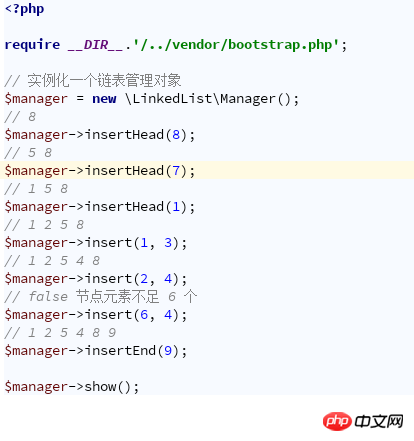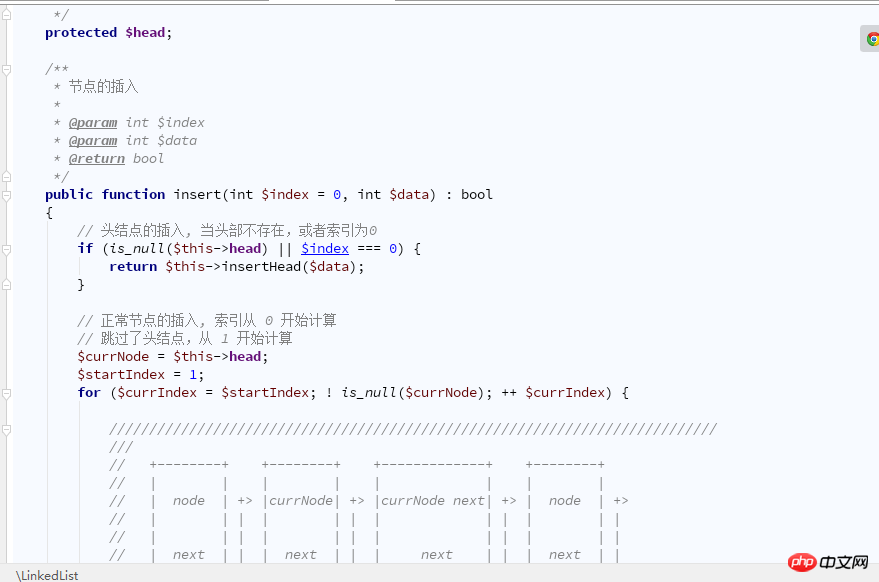Implémentation de liste chaînée en PHP
Le contenu de cet article concerne l'implémentation de listes chaînées en PHP. Il a une certaine valeur de référence. Maintenant, je le partage avec tout le monde. Les amis dans le besoin peuvent s'y référer
Commencez à vous renseigner sur les structures de données. 🎜 >
J'ai changé la police lors de l'écriture du code aujourd'hui. J'utilisais
et ça a l'air bien Aujourd'hui, j'ai trouvé un style que j'aime mieux console Source Code ProLes deux images ci-dessus sont toujours aussi belles. bien! ! ! 

Passons aux choses sérieuses et parlons du fonctionnement des listes chaînéesNoeud
- Il doit d'abord y avoir une classe de nœuds, utilisée pour stocker les données
<?phpnamespace LinkedList;class Node{
/**
* @var $data integer
*/
public $data; /**
* 节点指向的下一个元素
*
* @var $next Node
*/
public $next; public function __construct(int $data = -1)
{
public function __construct(int $data = null)
{
// 初始化赋值 data,也可通过 $node->data = X; 赋值
$this->data = $data;
}
}- Parce que le code de la classe d'opération est trop long, nous allons l'analyser par parties
- Écoutez le nom, vous saurez qu'un nœud est inséré depuis la tête
- Lorsque la liste chaînée est vide, le nœud actuel est initialisé
- Lorsque la liste chaînée n'est pas vide, insérez le nouveau nœud comme nœud principal
public function insertHead(int $data) : bool{
///////////////////////////////////////////////////////////////////////////
// +-----------+ +--------+ +--------+
// | | | | | |
// | head node | +> | node | +> | node | +>
// | | | | | | | | |
// | | | | | | | | |
// | next | | | next | | | next | |
// +------+----+ | +----+---+ | +----+---+ |
// | | | | | |
// +------+ +-----+ +-----+
///////////////////////////////////////////////////////////////
// +-----------+ +--------+ +--------+
// | | | | | |
// +---> | head node | +> | node | +> | node | +>
// | | | | | | | | | |
// | | | | | | | | | |
// | | next | | | next | | | next | |
// | +------+----+ | +----+---+ | +----+---+ |
// | | | | | | |
// +--------+ | +------+ +-----+ +-----+
// | | |
// |new node| |
// | | |
// | | |
// | next | |
// +----+---+ |
// | |
// +-----+
//
// 1. 实例化一个数据节点
// 2. 使当前节点的下一个等于现在的头结点
// 即使当前头结点是 null,也可成立
// 3. 使当前节点成为头结点
// 即可完成头结点的插入
$newNode = new Node($data); $newNode->next = $this->head; $this->head = $newNode; return true;
}public function insert(int $index = 0, int $data) : bool{
// 头结点的插入, 当头部不存在,或者索引为0
if (is_null($this->head) || $index === 0) { return $this->insertHead($data);
} // 正常节点的插入, 索引从 0 开始计算
// 跳过了头结点,从 1 开始计算
$currNode = $this->head; $startIndex = 1; // 遍历整个链表,如果当前节点是 null,则代表到了尾部的下一个,退出循环
for ($currIndex = $startIndex; ! is_null($currNode); ++ $currIndex) { ////////////////////////////////////////////////////////////////////////////
///
// +--------+ +--------+ +-------------+ +--------+
// | | | | | | | |
// | node | +> |currNode| +> |currNode next| +> | node | +>
// | | | | | | | | | | | |
// | | | | | | | | | | | |
// | next | | | next | | | next | | | next | |
// +----+---+ | +----+---+ | +------+------+ | +----+---+ |
// | | | | | | | |
// +-----+ +-----+ +--------+ +-----+
////////////////////////////////////////////////////////////////////////////
// +--------+ +--------+ +-------------+ +--------+
// | | | | | | | |
// | node | +> |currNode| +> |currNode next| +> | node | +>
// | | | | | | | | | | | |
// | | | | | | | | | | | |
// | next | | | next | | | next | | | next | |
// +----+---+ | +--------+ | +------+------+ | +----+---+ |
// | | +--------+ | | | | |
// +-----+ | | | +--------+ +-----+
// |new node| |
// | | |
// | | |
// | next | |
// +----+---+ |
// | |
// +-----+
////////////////////////////////////////////////////////////////////////////
//
// +--------+ +--------+ +-------------+ +--------+
// | | | | | | | |
// | node | +> |currNode| +> |currNode next| +> | node | +>
// | | | | | | | | | | | |
// | | | | | | | | | | | |
// | next | | | next | | | next | | | next | |
// +----+---+ | +----+---+ | +------+------+ | +----+---+ |
// | | | +--------+ | | | | |
// +-----+ | | | | +--------+ +-----+
// +----> |new node| |
// | | |
// | | |
// | next | |
// +----+---+ |
// | |
// +-----+
//
// 1. 当前索引等于传入参数的索引
// 2. 实例化新数据节点
// 3. 新节点的下一个指向当前节点的下一个节点
// 4. 当前节点的下一个节点指向新节点
if ($currIndex === $index) { $newNode = new Node($data); $newNode->next = $currNode->next; $currNode->next = $newNode; return true;
} // 移动到下一个节点
$currNode = $currNode->next;
} return false;
}Les deux ci-dessus sont les opérations de base de l'insertion. Jetez un œil à l’exemple de code.
<?php // 自动加载的代码就不贴了,直接在 githubrequire __DIR__.'/../vendor/bootstrap.php'; // 实例化一个链表管理对象$manager = new \LinkedList\Manager(); // 8$manager->insertHead(8); // 5 8$manager->insertHead(5); // 1 5 8$manager->insertHead(1); // 1 2 5 8$manager->insert(1, 2); // false 节点元素不足 6 个$manager->insert(5, 4); // 1 2 5 8 9$manager->insertEnd(9); // 3$manager->find(8); // 1 2 8 9$manager->delete(2);
- Trouver la valeur de la liste chaînée est également très simple, il suffit de la parcourir
/**
* 查找链表的值中的索引
* 成功返回索引值,找不到返回 -1
*
* @param int $data
* @return int
*/public function find(int $data) : int{
$currNode = $this->head; // 查找还是很简单的,只要遍历一次链表,然后再判断值是否相等就可以了
for ($i = 0; ! is_null($currNode); ++ $i) { if ($currNode->data === $data) { return $i;
} $currNode = $currNode->next;
} return -1;
}- Vous n'avez besoin de parcourir la liste chaînée qu'une seule fois, de trouver des valeurs égales et de renvoyer la valeur d'index si elle est trouvée. Si elle n'est pas trouvée, renvoyez -1
/**
* 删除链表的节点
*
* @param int $index
* @return bool
*/public function delete(int $index) : bool{
// 没有任何节点,直接跳过
if (is_null($this->head)) { return false;
} elseif ($index === 0) { // 头结点的删除
$this->head = $this->head->next;
} // 这里的开始的索引是 1
// 但当前节点指向的确实 头结点
// 因为删除的时候必须标记删除的前一个节点
// for 的判断是判断下一个节点是否为 null
// $currNode 是操作的节点
// $currNode->next 是要删除的节点
$startIndex = 1; $currNode = $this->head; for ($i = $startIndex; ! is_null($currNode->next); ++ $i) { if ($index === $i) { // 使当前节点等于要删除节点的下一个
// 即可完成删除
$currNode->next = $currNode->next->next; break;
} $currNode = $currNode->next;
} return true;
}- Le code a été hébergé sur github
- Il sera temps de continuer à apprendre les structures de données , des listes doublement chaînées, des arbres et autres ! ! !
php pour implémenter l'ordre inversé des listes chaînées
Utiliser PHP pour implémenter une liste chaînée unique
Comment implémenter une liste doublement chaînée et la trier en PHP
Ce qui précède est le contenu détaillé de. pour plus d'informations, suivez d'autres articles connexes sur le site Web de PHP en chinois!

Outils d'IA chauds

Undresser.AI Undress
Application basée sur l'IA pour créer des photos de nu réalistes

AI Clothes Remover
Outil d'IA en ligne pour supprimer les vêtements des photos.

Undress AI Tool
Images de déshabillage gratuites

Clothoff.io
Dissolvant de vêtements AI

AI Hentai Generator
Générez AI Hentai gratuitement.

Article chaud

Outils chauds

Bloc-notes++7.3.1
Éditeur de code facile à utiliser et gratuit

SublimeText3 version chinoise
Version chinoise, très simple à utiliser

Envoyer Studio 13.0.1
Puissant environnement de développement intégré PHP

Dreamweaver CS6
Outils de développement Web visuel

SublimeText3 version Mac
Logiciel d'édition de code au niveau de Dieu (SublimeText3)
 Guide d'installation et de mise à niveau de PHP 8.4 pour Ubuntu et Debian
Dec 24, 2024 pm 04:42 PM
Guide d'installation et de mise à niveau de PHP 8.4 pour Ubuntu et Debian
Dec 24, 2024 pm 04:42 PM
PHP 8.4 apporte plusieurs nouvelles fonctionnalités, améliorations de sécurité et de performances avec une bonne quantité de dépréciations et de suppressions de fonctionnalités. Ce guide explique comment installer PHP 8.4 ou mettre à niveau vers PHP 8.4 sur Ubuntu, Debian ou leurs dérivés. Bien qu'il soit possible de compiler PHP à partir des sources, son installation à partir d'un référentiel APT comme expliqué ci-dessous est souvent plus rapide et plus sécurisée car ces référentiels fourniront les dernières corrections de bogues et mises à jour de sécurité à l'avenir.
 CakePHP travaillant avec la base de données
Sep 10, 2024 pm 05:25 PM
CakePHP travaillant avec la base de données
Sep 10, 2024 pm 05:25 PM
Travailler avec la base de données dans CakePHP est très simple. Nous comprendrons les opérations CRUD (Créer, Lire, Mettre à jour, Supprimer) dans ce chapitre.
 Date et heure de CakePHP
Sep 10, 2024 pm 05:27 PM
Date et heure de CakePHP
Sep 10, 2024 pm 05:27 PM
Pour travailler avec la date et l'heure dans cakephp4, nous allons utiliser la classe FrozenTime disponible.
 Téléchargement de fichiers CakePHP
Sep 10, 2024 pm 05:27 PM
Téléchargement de fichiers CakePHP
Sep 10, 2024 pm 05:27 PM
Pour travailler sur le téléchargement de fichiers, nous allons utiliser l'assistant de formulaire. Voici un exemple de téléchargement de fichiers.
 Discuter de CakePHP
Sep 10, 2024 pm 05:28 PM
Discuter de CakePHP
Sep 10, 2024 pm 05:28 PM
CakePHP est un framework open source pour PHP. Il vise à faciliter grandement le développement, le déploiement et la maintenance d'applications. CakePHP est basé sur une architecture de type MVC à la fois puissante et facile à appréhender. Modèles, vues et contrôleurs gu
 CakePHP créant des validateurs
Sep 10, 2024 pm 05:26 PM
CakePHP créant des validateurs
Sep 10, 2024 pm 05:26 PM
Le validateur peut être créé en ajoutant les deux lignes suivantes dans le contrôleur.
 Journalisation CakePHP
Sep 10, 2024 pm 05:26 PM
Journalisation CakePHP
Sep 10, 2024 pm 05:26 PM
Se connecter à CakePHP est une tâche très simple. Il vous suffit d'utiliser une seule fonction. Vous pouvez enregistrer les erreurs, les exceptions, les activités des utilisateurs, les actions entreprises par les utilisateurs, pour tout processus en arrière-plan comme cronjob. La journalisation des données dans CakePHP est facile. La fonction log() est fournie
 Comment configurer Visual Studio Code (VS Code) pour le développement PHP
Dec 20, 2024 am 11:31 AM
Comment configurer Visual Studio Code (VS Code) pour le développement PHP
Dec 20, 2024 am 11:31 AM
Visual Studio Code, également connu sous le nom de VS Code, est un éditeur de code source gratuit – ou environnement de développement intégré (IDE) – disponible pour tous les principaux systèmes d'exploitation. Avec une large collection d'extensions pour de nombreux langages de programmation, VS Code peut être c






